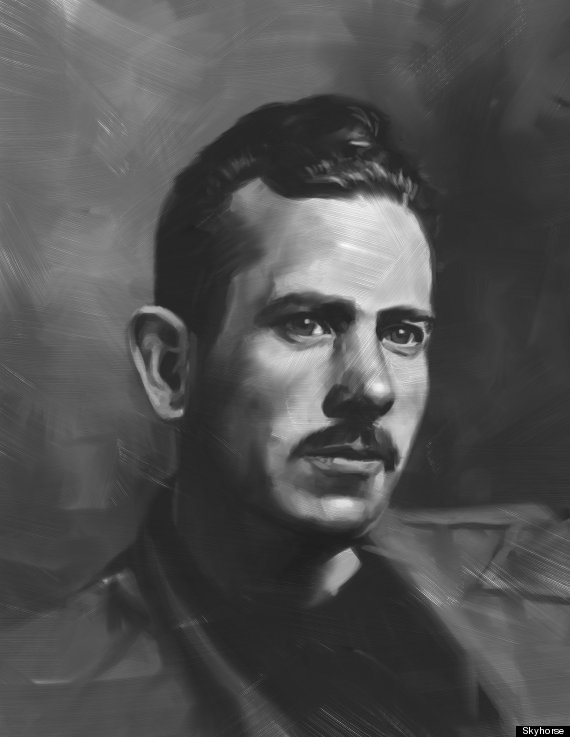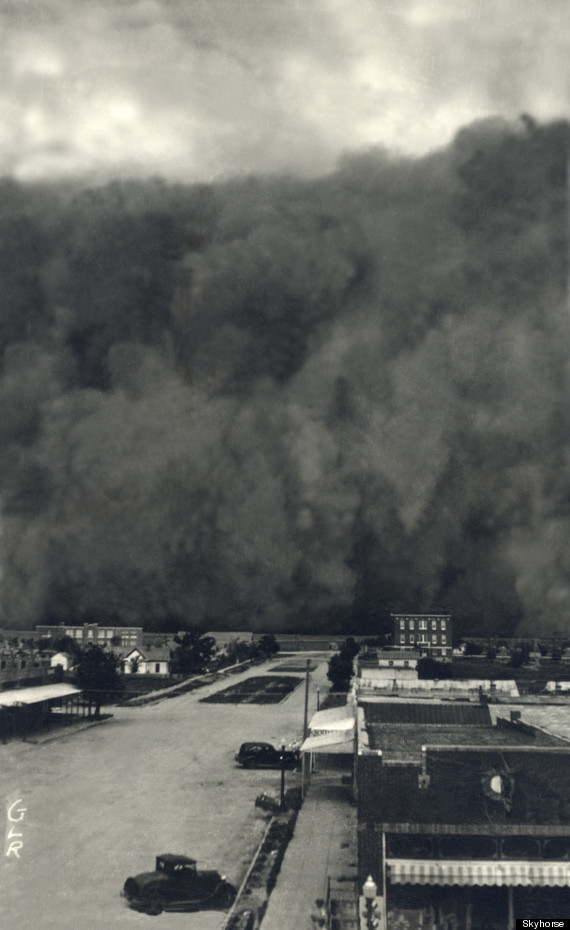
The following is an excerpt from "Route 66 Still Kicks" [Skyhorse Publishing, $16.95]:
It was near here in the 1930s that a thirty-four-year-old writer conceived his major work, a novel in which Oklahoma was a corner of the larger canvas. That book would portray dispossessed people heading west in the Dust Bowl exodus, traveling on Highway 66, “the main migrant road... waving gently up and down on the map... over the red lands and the gray lands, twisting up into the mountains...”
In 1937, Californian John Ernst Steinbeck was courting celebrity with the sales and reviews of his novel "Tortilla Flat." He and his wife, Carole, returning from a European trip, had recently arrived in Chicago — where they purchased a Victory Red 1936 Chevrolet, a stylish sedan with a steep-nose chrome grill — likely a showroom car being cleared to make way for next year’s models. The Steinbecks left for a late-summer drive on what the author termed the “long concrete path.”
They traveled west on Route 66 with a road map that later provided the place names and reminders for the fictional account of the Joad family’s voyage. In his journal, Steinbeck wrote of seeing people and cars “panting across the country.” Later legend would make much of this trip’s role in the writing of "The Grapes of Wrath," describing it as part of the author’s preparations and, at its core, a study trip. Various biographers stated that Steinbeck specifically wanted to retrace the route where, only a few years earlier, migrants had shifted west to where they’d heard there was no Depression: California. Some writers noted, incorrectly, that Steinbeck had lived and moved with a migrant family on their journey, portraying them as the Joad family in his eventual book. It was not that way at all. It was a vacation for John and his wife of six years; Carole would later say that their travels were without “conscious effort to do any research for his book along the way to California.”
Steinbeck never returned to Oklahoma after reaching the coast. In California, he spent several weeks doing research for his writing, research that resulted in over half of the novel being set in the state of California. It was there, while on several magazine assignments, that he visited the migrant shantytowns, as well as the more tolerable government camps. And where, en route, he says he “saw people starve to death ... they dropped dead.”
Though he visited Oklahoma only once, Steinbeck chose to emphasize the “Okies” image over those of the “Arkies” and “Texacanos,” all derogatory designations used by California border guards and employers to describe the oversupply of workers offering cheap labor. He wrote of the migrants’ fractured quests, their broken cars and unraveled hopes, and of the “scarred earth” they left behind, the squalor of squatter camps and the dismal chances of success.
In "The Grapes of Wrath," Steinbeck wrote:
66 is the path of a people in flight, refugees from dust and shrinking land, from the thunder of tractors and shrinking ownership, from the desert’s slow northward invasion, from the twisting winds that howl up out of Texas, from the floods that bring no richness to the land and steal what little richness is there. From all of these the people are in flight, and they come into 66 from the tributary side roads, from the wagon tracks and the rutted country roads. 66 is the mother road, the road of flight.
The factual backbone of the novel grew from seven articles commissioned by the San Francisco News to portray the migrants’ hardships and their distraught circumstances. Steinbeck had earlier written a magazine article about migrants, with “their pitiful household goods,” traveling in “rattletrap cars.” The series, “The Harvest Gypsies,” appeared in 1936. Collected later into a pamphlet, the thesis was emboldened with a new title: "Their Blood Is Strong," in which Steinbeck wrote: “Thousands of them are crossing the borders in ancient rattling automobiles, destitute and hungry and homeless” and of the migrants “having used up every resource to get here, even to selling of the poor blankets and utensils and tools on the way to buy gasoline.” Gasoline was twelve cents a gallon.
Steinbeck began working on a book-length manuscript around this time, using the working title The Oklahomans. He claimed the draft was intentionally destroyed in the fall of 1936.
Carole Steinbeck, poet and gardener, became her husband’s first reader through her typing of a manuscript that he scrawled longhand in a green ledger. As she transcribed her husband’s two hundred thousand words, she offered editorial suggestions, sought clarifications, and provided encouragement. She also gave the novel its title, from “The Battle Hymn of the Republic,” by Julia Ward Howe. The words appear in the first verse: “Mine eyes have seen the glory of the coming of the Lord; He is trampling out the vintage where the grapes of wrath are stored...” The book’s English-language title translated into foreign-edition titles such as Angry Grapes in Germany and Rage of Grapes in Japan. These translations (perhaps even their titles) and the subsequent movie based on the book created an international mystique for Route 66.
A simple telling of the novel goes like this. It is Oklahoma, 1930. A young man, Tom Joad, returns home from the Oklahoma State Penitentiary, where he’s been imprisoned for four years for killing a man in a beer brawl. Near the family farm Tom meets Jim Casy, a disenchanted preacher who is no longer in the fold, though he’d once baptized the baby Tom. Together they discover the Joad family’s abandoned farm, the house of broken windows and swirls of prophetic dust. Tom soon finds his family at his uncle’s tenant farm. They have received a notice from the landlord to move on from there, too. The banks are without compassion, and the landowners are empowered with new financing to purchase Caterpillar tractors that can efficiently plant and harvest consolidated farms. The story plays out against the harshness of the elements — zero precipitation, stunted crops, severe winds, and dust storms that are “blowin’ the land away...”
The entire Joad family — Tom’s strong Ma and steady Pa, faltering Grandpa and spitting Grandma, and siblings Noah, Al, Winfield, and Ruthie — are as emotionally tethered to the jalopy truck as are their tied-down family possessions. They have “no place to live but on the road.”
Steinbeck then introduces Tom’s sister, Rosasharn (Rose of Sharon), and her husband, Connie. They, too, are passengers. Her pregnancy and eventual loss of their baby provide the novel with a controversial summation in which she uses her breast milk, meant for her now-dead child, to suckle a dying man.
The year 1936 alone saw ninety thousand Okies enter California. Many did so after a four- or five-day journey, arriving to join family or friends already residing there. Of the perhaps hundreds of thousands of people who arrived during the 1930s, it has been suggested that fewer than sixteen thousand experienced the Joad chronicle of home eviction, despairing driving, and broken hopes upon their arrival in California.
“I am scared it will not be a popular book,” Steinbeck wrote in his journal. The novel’s release in the spring of 1939 brought an immediate backlash from Oklahoma, where Steinbeck’s portrayal was considered insulting. It also raised the ire of employers in California, who felt besmirched. Libraries in places such as St. Louis and in Steinbeck’s hometown of Salinas, California, banned the book over its use of “dirty words,” despite the publisher’s New York editor having ventured to California to persuade Steinbeck to tone down the language. (The editor then offended the reluctant telegraph operator, when she sent the “dirty words” editorial changes back to New York via Western Union.)
More than 430,000 copies of "The Grapes of Wrath" were distributed in the next eight months, a hint of the eventual millions to be sold — despite Steinbeck’s fears of low readership. However, he never underestimated the impact it could have, writing in his journal: “If only I could do this book properly it would be one of the really fine books and a truly American book.”
In a novel of thirty chapters, it is the twelfth chapter — fewer than five pages — that poignantly casts Route 66 into the world’s literary pond, spreading ripples of recognition upon publication.
Steinbeck kept a diary in which he foreshadowed that this would be his big book. From these notations we also know of his anxieties and insecurities, notwithstanding his usual outward display of confidence. “I know this … a man got to do what he got to do,” he writes in the Joads’ story. The mental and physical demands of his five-month marathon of writing the novel left him so exhausted that he did not write again for nearly a year.
Fame undermines many marriages. The resounding success of "The Grapes of Wrath" affected Steinbeck’s, as well, possibly helping to end the first of his three marriages in 1941.

John Steinbeck, author of The Grapes of Wrath, gave Route 66 its most famous moniker, “The Mother Road.” He once wrote: “A book is like a man — clever and dull, brave and cowardly, beautiful and ugly.”
The thunder of it all. Unimaginable. Untold tons of dust. Rapid, fierce swirls of dirt and grit. A sky turned enemy — an enemy with a decade-long vengeance that became known as the Dirty Thirties.